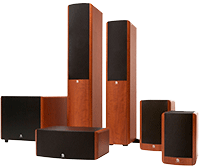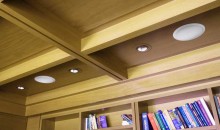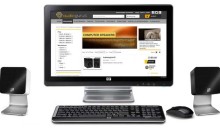Are Wireless Home Theater Speakers on the Horizon?
With all the talk about wireless home theater speakers, you’d think we’d have a dozen or so models to choose from. You would imagine store shelves lined with various flavors, styles, sizes and price points for the discerning consumer to select from. You would suppose that there would be high end models that focused on pristine sound quality and inexpensive models that hid themselves away from sight. And you’d certainly think Bose would have brought something to market by now. But that’s not the case. Wireless home theater speakers have simply not materialized—at least not in massive quantities or any systems that have achieved anything more than a blip on the radar. The closest we’ve seen is the short-lived Aperion Audio Intimus 4T Summit Wireless Speaker System. That system was powered by Summit Audio’s wireless system and they were an advisory board member of WISA, the Wireless Speaker & Audio Association. Now, there are scant products. One of them is the Bang & Olufsen BeoLab 20 and another is the Samsung Shape system.
Wireless Home Theater Speakers are a Great Idea
There’s nothing wrong with the idea of wireless home theater speakers. In fact, in a world of convenience and shrinking home theater, they actually make a lot of sense. Wireless home theater speakers would mean that you no longer need to run wires to your main, center or surround speakers. That means you no longer have to take into account placement issues or having to run cabling to your surrounds in a more difficult installation. There’s no need to do an attic cable installation or utilize crown moulding to install speaker wire. Wireless speakers are a way to open up aesthetics, give you greater placement flexibility, and free you from having to take into account most cabling considerations when putting your speakers in a living space. The use of wireless speakers in home theater also lets you do even neater things, like reassign speakers at-will or send particular audio to different locations based on speaker addressing. When talk of wireless speakers started going mainstream, I wondered how long it would take before that method of thinking spread throughout the home into whole home audio systems. As it turns out, wireless didn’t affect assignability much, but the idea of “addressing” various speakers with particular channels of audio has indeed taken place (and has been taking place)—just without the wireless technology.
Wireless Speakers Still Have Wires
Possibly the biggest impediment to the adoption of wireless speakers is that…well…they still have wires. Oops. While those of us who know better weren’t fooled by the term, a lot of people were truly hoping you’d plunk down a speaker into a room and walk away. The fact of the matter is, you need to connect each speaker to power. And battery power isn’t enough to truly get enough run-time, power, or reliability out of a speaker (plus, you still have to charge it). Contrary to popular belief, there’s still no free lunch. What a wireless speaker does is remove the need for signal cabling (speaker cables). And since it’s almost always easier to locate power than find a way to run speaker cables, wireless speakers are far easier to place and install. It’s the need to plug in a power cord that may be responsible for souring public opinion on wireless speakers.
Wireless Speakers Must Include Amplifiers
Another oft overlooked fact is that wireless speakers need to include amplification. This has some significant implications. First, it means that the speaker system is going to cost a lot more. Why? Well, a powered speaker must be designed just as well as a passive speaker, but it must also include amplifiers to power the drivers. That’s a big deal. The other thing that happens is that you now require a way to output the required signals to the speakers. Many of the early systems (like the 2012 Summit Wireless system I previewed at the CEDIA Expo) included a black box with HDMI inputs as well as digital audio inputs. For users who want to use wireless home theater speakers in a system with an AV receiver, you will have an additional layer of complexity added and may even lose some features in the process.
Conclusion
Possibly the final nail in the coffin of wireless home theater systems (though we’re absolutely convinced the dead can’t be resurrected) is this statement on the WISA website:
Unlike traditional home theater systems, a WiSA-enabled system can be quickly set up by the average user without the expense of hiring a professional installer.
If WISA hopes to gain wide acceptance as a wireless home theater speaker solution it must be a bit more careful in its wording with respect to the people who put those systems in place. I think it’s safe to say that WISA was simply attempting to be accommodating to the consumer—and truly its system is incredibly easy to use. The use of a professional installation company, however, can achieve far more for consumers—even if the general configurability of a wireless speaker system can be quickly accomplished. For now, single wireless speakers are taking off in droves. They may be AirPlay or Bluetooth (or some other proprietary format), but people are enjoying directly connecting their iOS and Android devices with speakers. As that trend expands, perhaps we’ll see more interest in tackling more of the challenges with wireless home theater speaker systems.
Plan Your Next Steps
[bscolumns class=”one_half”]
Start Shopping
The Audiogurus Advantage
[/bscolumns] [crp limit=”6″ heading=”1″ cache=”1″]
Finished Researching?







